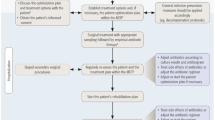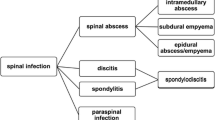Abstract
Background
Multiple studies have reported on the risks and preventative measures associated with acute surgical site infection (SSI) in patients with adolescent idiopathic scoliosis (AIS). Few studies have evaluated treatment and results. The purpose of this study was to evaluate the need for development of best practice guidelines based on the management of an acute SSI across 9 different centers.
Methods
A prospectively collected, multicenter database of patients undergoing surgical correction of AIS was reviewed for all acute SSI. Infection characteristics, treatment methods, and outcomes were summarized.
Results
Twenty-three (0.6%) from a total of 3926 AIS patients were treated for an acute SSI, all of which resolved. Twenty patients had documentation of the infection treatment (10 deep infections, 10 superficial). All ten patients with deep infections underwent operative incision and drainage. Six patients ultimately found to have a superficial infection underwent I&D and another 3 had dressing changes in the office. In the deep group, one patient had instrumentation exchanged and seven patients had bone graft removed. All 16 patients who underwent operative I&D had cultures obtained with 11 positive cultures. All deep infection patients were started on IV antibiotics for 2 days to 6 weeks prior to conversion to oral antibiotics. Five of six operative superficial infections were begun on IV antibiotics with conversion to oral antibiotics. Total antibiotic administration ranged from 5 days to 7 months in the deep infection group and 1 to 6 weeks in the superficial group.
Conclusions
While deep infections are consistently treated with I&D, there is significant variability in the surgical and medical management of acute SSI. Considering the universal resolution of the infection, there is opportunity for the development of BPG to minimize treatment morbidity and cost, while optimizing outcomes for this major complication.
Level of evidence
Therapeutic-IV.
Similar content being viewed by others
References
Bartley CE, Yaszay B, Bastrom TP et al (2017) Perioperative and delayed major complications following surgical treatment of adolescent idiopathic scoliosis. J Bone Joint Surg Am 99:1206–1212
Marks MC, Newton PO, Bastrom TP et al (2013) Surgical site infection in adolescent idiopathic scoliosis surgery. Spine Deform 1:352–358
Hedequist D, Haugen A, Hresko T et al (2009) Failure of attempted implant retention in spinal deformity delayed surgical site infections. Spine (Phila Pa 1976) 34:60–64
Dummit L, Marrufo G, Marshall J, Tan E, Bradley A, Hall C et al (2016) CMS bundled payments for care improvement initiative models 2–4 : year 2 evaluation & monitoring annual report. The Lewin Group, Falls Church
CDC (2018) Surgical site infection (SSI) event. CDC, Atlanta
Glotzbecker MP, Riedel MD, Vitale MG et al (2013) What’s the evidence? Systematic literature review of risk factors and preventive strategies for surgical site infection following pediatric spine surgery. J Pediatr Orthop 33:479–487
Vitale MG, Riedel MD, Glotzbecker MP et al (2013) Building consensus: development of a best practice guideline (BPG) for surgical site infection (SSI) prevention in high-risk pediatric spine surgery. J Pediatr Orthop 33:471–478
Li Y, Glotzbecker M, Hedequist D (2012) Surgical site infection after pediatric spinal deformity surgery. Curr Rev Musculoskelet Med 5:111–119
Reames DL, Smith JS, Fu KM et al (2011) Complications in the surgical treatment of 19,360 cases of pediatric scoliosis: a review of the Scoliosis Research Society Morbidity and Mortality database. Spine (Phila Pa 1976 36:1484–1491
Blumstein GW, Andras LM, Seehausen DA et al (2015) Fever is common postoperatively following posterior spinal fusion: infection is an uncommon cause. J Pediatr 166:751–755
Ho C, Skaggs DL, Weiss JM et al (2007) Management of infection after instrumented posterior spine fusion in pediatric scoliosis. Spine (Phila Pa 1976) 32:2739–2744
Picada R, Winter RB, Lonstein JE et al (2000) Postoperative deep wound infection in adults after posterior lumbosacral spine fusion with instrumentation: incidence and management. J Spinal Disord 13:42–45
Rihn JA, Lee JY, Ward WT (2008) Infection after the surgical treatment of adolescent idiopathic scoliosis: evaluation of the diagnosis, treatment, and impact on clinical outcomes. Spine (Phila Pa 1976) 33:289–294
Aydinli U, Karaeminogullari O, Tiskaya K (1999) Postoperative deep wound infection in instrumented spinal surgery. Acta Orthop Belg 65:182–187
Acknowledgements
This study was supported in part by grants to the Setting Scoliosis Straight Foundation in support of Harms Study Group research from DePuy Synthes Spine, EOS imaging, K2M, Medtronic, NuVasive and Zimmer Biomet.
Funding
Research funding was received in support of this work.
Author information
Authors and Affiliations
Corresponding author
Ethics declarations
IRB
IRB approval was obtained for this study.
Additional information
Publisher’s Note
Springer Nature remains neutral with regard to jurisdictional claims in published maps and institutional affiliations.
Rights and permissions
About this article
Cite this article
Bachmann, K.R., Yaszay, B., Bartley, C.E. et al. The variability in the management of acute surgical site infections: an opportunity for the development of a best practice guideline. Spine Deform 8, 463–468 (2020). https://doi.org/10.1007/s43390-020-00079-4
Received:
Accepted:
Published:
Issue Date:
DOI: https://doi.org/10.1007/s43390-020-00079-4




